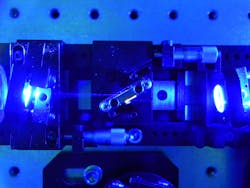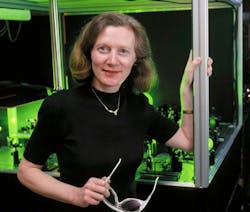Future Optics: Ultrafast optics and photonics open up new discoveries - Interview with Margaret Murnane
OSA: What interested you in optics?
Margaret Murnane: Growing up in rural Ireland along the River Shannon, I was fascinated by the colors reflected on the water and the beauty of our natural world. I got interested in atomic spectra and x-rays at the University of Cork, where my optics professor was an expert in string theory but was an amazingly enthusiastic lecturer, and gave us very challenging questions.OSA: What got you interested in ultrafast lasers?
MM: I did my PhD at Berkeley with Roger Falcone. We fired 100 fs laser pulses at a solid to produce short x-ray bursts. The laser pulses are faster than the explosion time of a hot solid-density plasma, so we actually made a plasma mirror. I built the femtosecond laser and amplifier using a colliding pulse design from Chuck Shank to produce x-ray pulses lasting 1.1 ps, plus or minus a picosecond. Nowadays, our measurements have attosecond precision—more than six orders of magnitude shorter in duration.
OSA: What led you to titanium sapphire lasers?
MM: My husband and research partner, Henry Kapteyn, and I started a lab at Washington State University in 1990, when Wilson Sibbett had just demonstrated self modelocking of titanium sapphire (Ti:sapphire; see figure). We were very interested in generating very short pulses of light, and were puzzled that the pulses lasted 60 fs when the huge bandwidth of Ti:sapphire should have made them much shorter.
We did an analysis with one of our first students, Chung-Po Huang, and found that high-order dispersion in the cavity limited the bandwidth. We thought highly doped laser crystals and a pair of intracavity dispersion-compensating prisms could reduce dispersion. Working with Milan Kokta and George Venikouas at Union Carbide, we were able to get super-broad bandwidth growing highly-doped crystals. The beautiful thing about the physics is that broadening the bandwidth makes the laser more stable, so we made an 11 fs laser.
We never patented it, and laser companies didn't think anyone needed 11 fs lasers, but our colleagues would ask Henry for the design—and we shared them freely (via snail mail). Then, some folks didn't want to build the laser, so they asked Henry for kits and he started providing them. That's how we started our company, Kapteyn-Murnane Labs (KMLabs), working in the basement and aligning the rail setting up the kit so laser experts could finish assembly.
OSA: What kept you working on ultrafast lasers?
MM: With graduate students Sterling Backus and Jianping Zhou, we learned how to make laser amplifiers produce very intense pulses just as high-harmonic generation was taking off. We showed that our very short pulses were better for high harmonics than other lasers. So, our careers evolved from developing very short pulse lasers to developing very short high-harmonic pulses, and now we mainly apply those ultrashort pulses in nanotechnology and materials science.
High-harmonic sources have very high temporal and spatial coherence, so they can achieve very high temporal and spatial resolution. Essentially, the laser ionizes an atom, creating a nanoscale quantum antenna from the electron wave function, and modulates the antenna so it looks like we are driving it at a high harmonic of the fundamental laser frequency. This lets us achieve spatial resolution equal to the high-harmonic wavelength better than any other x-ray microscope.
We get coherent emission from multiple atoms that is passively phase-matched with sub-angstrom precision and attosecond temporal resolution. This beautiful phase-matching happens automatically over a few cycles of the driving laser pulse. The efficiency is relatively low—10-3 in the vacuum ultraviolet (VUV) and 10-5 in the extreme ultraviolet (EUV)—and so far, only 10-8 has been demonstrated in the soft x-ray region. But the beam is tightly collimated, so giving enough power for many experiments and pulses from the tabletop source can span 10 octaves.
OSA: What opportunities does this new source offer?
MM: Many x-ray measurements work better with short pulses and coherent light. X-rays penetrate opaque samples, and they have sharp absorption edges for spectroscopy. They can measure the magnetic moments of the entire element in an alloy simultaneously, and have a wide range of uses in condensed matter physics, energy research, nanotechnology, and imaging.
OSA: How do you develop both new sources and new applications?
MM: The company took over laser development and engineering. Engineering makes the lasers more capable. We are quantum physicists and know what lasers are needed. The two are very complementary, as the company does the engineering to help us do more difficult experiments. Henry deserves all the credit for the company.
OSA: How did your 2000 MacArthur Foundation Fellowship affect you?
MM: It helped tremendously in rebuilding our labs at the University of Colorado, and to develop high-harmonic sources and find important applications for them. It also helped give us credibility to try new and bigger ideas.
OSA: You also are involved in service projects. What have you worked on?
MM: I served on an American Physical Society committee on the status of women in physics. We visited physics departments and advised them how to make physics more attractive for women. The committee raises awareness and develops best practices, like making the tenure system compatible with having a family, and having a standard code of conduct.
This is a huge change from when I was in grad school, when people often said things that discouraged women without intending to. Many women have worked hard to make this happen, like Judy Franz, Meg Urry, Mildred Dresselhaus, and many more. We're not there completely yet, but the slope is positive—very positive. When you don't have women in technology, it's because the climate isn't attractive and you're missing half your talent pool. The more diverse and inclusive an organization is, the more respectful of multiple viewpoints and the more rapidly it can change, which is essential in our global environment. The Optical Society also works very hard on this.
OSA: What exciting things are coming in the very fast and very small?
MM: We don't know. We know we can see the fastest electron motion and we can build extremely powerful microscopes, and we would like to combine the two to record images on relevant lengths and time scales. But modeling the process would require combining the quantum time-dependent Schrödinger equations with Maxwell's equations, and that's so computationally intensive that we can't calculate the limits of the technology. So, we explore and end up discovering new and useful things.
For example, one very unusual discovery came when we heated patterns of nanodots with a laser to stimulate hot spots in a nanocircuit. We expected packing the hot spots closer to slow down their cooling, but we found that closer hot spots actually cool faster. Now, we understand how that happens—the heat-carrying phonons couple better to the substrate from close-packed nanodots, essentially cooling the hot spots faster. It's cute physics, and it's important in circuit design or general thermal engineering. Physics in the nano-world is different than in the macroscopic, so sometimes your intuition is backwards.
MARGARET MURNANE is a professor of physics at the University of Colorado and a fellow at JILA. She studies ultrafast optical and x-ray science, and pioneered high-harmonic generation and applications using ultrafast lasers. She is a fellow of The Optical Society and the American Physical Society, and received a MacArthur Fellowship in 2000.

